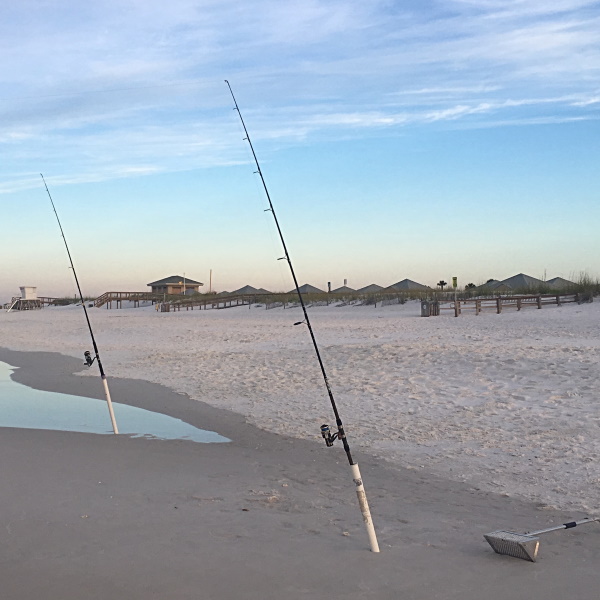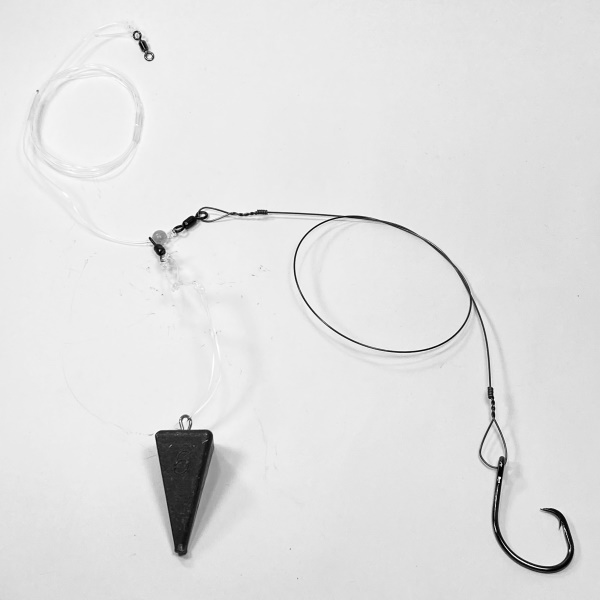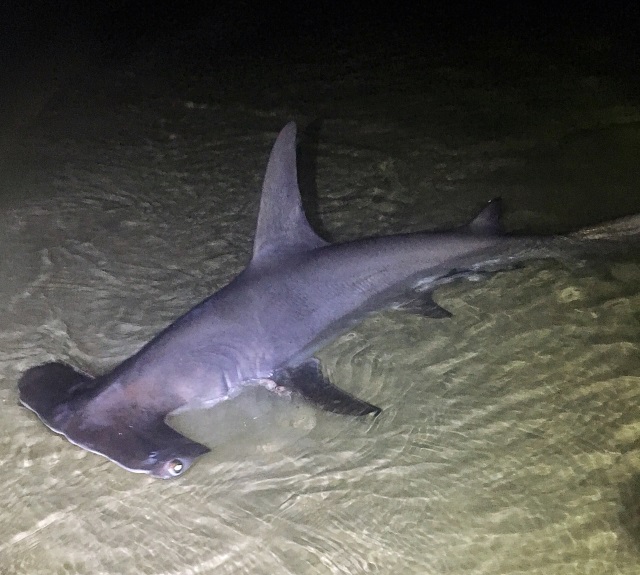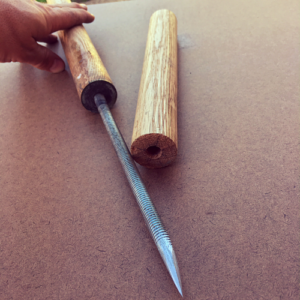*As an Amazon Associate I earn from qualifying purchases.

You ever wondered why you see anglers using such long fishing rods at the beach? It’s certainly attention grabbing isn’t it. Well, attention is not why surf fishermen choose to use really long rods. As you’ll see below, they provide beach fishermen with several key benefits, some more important than others.
Benefits Of A Long Surf Fishing Rod
- Produces longer casts
- Keeps your line above the waves
- Raises your line above beach goers
- Allows longer fishing leaders
- Quicker hook sets
Longer Rods Cast Further
The number one reason you see long rods at the beach is that they cast further. But, as with anything, there is a point of diminishing return. A longer rod only increases your casting distance up to a certain point, then you’ll actually start losing distance the longer you go. A 15 footer is probably about the biggest rod you’ll see out there, but for me, that’s way too long. Once you go over about 12 feet, it starts becoming more unwieldy and difficult to cast. My own preference to achieve maximum distance is between 10 and 12 feet.
Rods Over 9 Feet Keep Your Line Above Crashing Waves
If you’re bottom fishing with your rods in sand spikes, you generally want your bait to stay pinned down, or at the very least, drift very slowly. The waves are always working against you in this regard. They pull at your line, and can dislodge your sinker from the sand. This is even more of a problem when there is grass and other such debris in the water. Grass collects on your line and creates even more surface area for the waves to grab hold of.
Sometimes you’ll look up and your bait might be lying on the sand 75 yards down the beach. Lengthy fishing rods will help prevent this, as they keep your line high above the largest breaking waves. By keeping your line high, you reduce drag on your line in the water. This goes a long way in preventing your bait from getting pulled out of position.
Even if your bait doesn’t get washed onto shore by these crashing waves, it can still be pushed around, causing slack in the line. A drooping line makes it nearly impossible to detect bites.
Your Fishing Line Is Above Passing Tourists
Tourists and beach goers are not going to be a problem everywhere you fish. But, they seem to be an obstacle everywhere I fish.
Most of my surf fishing involves bottom fishing with my rods anchored in sand spikes. It’s common to have several different lines strung out along the shoreline in front of me.
Bottom fishing like this, with rods in sand spikes, isn’t usually a problem. Most beach goers will politely walk behind your setup as they make their way down the shoreline.
However, sometimes passing beach goers seem to be oblivious that they could be walking face first into your fishing lines. So, I do both me and them a favor, and use long rods. It gives them plenty of space to walk underneath my lines, and everybody stays happy.
The Longer The Rod, The Longer The Leader You Can Use

With a longer rod, you can cast a longer leader. There are several reasons you might want to do this.
Using leaders for line shy fish – Some fish, such as spanish mackerel, are line shy in clear water. If you’re using a braided main line, as I do, this can be a problem. To overcome the visibility issues with braid, I tie on a length of monofilament or flourocarbon to the end of my braided main line. With a longer rod, you can make such a leader longer without having to reel the knot or swivel through the rod’s guides.
Extra length for cutoffs – When fishing for toothy fish with a monofilament leader, you’re either going to get bit off occasionally, or your leader is going to get beat up near the hook end. So, you’ll have to occasionally retie the end of your rig. Having a longer leader buys you more time before you have to completely re-attach a new section of leader.
Shark leaders – When casting for sharks, you need both a short section of wire, and a length of thick monofilament leader. That’s going to be too much length to effectively cast with a “normal rod”. However, with a long enough rod, you can cast up to a 6 foot shark leader without reeling any part of it through the rod’s guides.
One way to overcome the shortcomings of a shorter rod is to use a small profile FG knot to tie on your leader. With such a small knot, you can actually reel part of your shark leader through the rod guides when casting.
Quicker Hook Sets
A longer rod is going to sweep up more line quickly, thus resulting in a quicker hook set.
A quick hook set may, or may not be, relevant to you. I like to set a hook quickly when I’m casting lures at passing schools of fish. However, when I’m bottom fishing with circle hooks, there is no need for a quick hook set.
Long Surfcasting Rod Negatives
There are some other negatives that come to mind when using over sized fishing rods.
- Transportation difficulties
- Fatigue
- Longer surfcasting rods are more expensive
- Reduced ability to fight big fish
- Reduced casting accuracy
Transporting A Long Rod Can Be Difficult
Another drawback to long fishing rods is the difficulty of transporting them without damaging them. I prefer 2 piece rods for this very reason. Following are some ways you can transport long surf rods.
Sandwich them – What I usually do is break my rods down when transporting them. I sandwich them together using Night Ize rubber gear ties. This creates a compact package that doesn’t rattle on the car ride. This is certainly not the most convenient way, but it’s what I have been doing lately.
Put them in a pvc tube – I used to break my rods in two, and shove them inside a large capped pvc tube. I found this to be overkill, and I didn’t like my rods bouncing against each other inside the tube.
Roof racks – I see some of the East coast guys transporting their rods on top of their vehicles in some sort of rack. This looks like a good option if you have the vehicle to support the rack. However, in the densely populated areas I fish, I’d be scared to leave high end rods sitting on top of my vehicle for someone to steal.
Stick them out the window – I have done it. Yep. I have run my poles through the rear window and down the length of my cab as far as they would go. Then, I let the top half hang out the window like a cluster of cane poles. This is certainly not a preferred method, as the rods will be slapping against each other. Maybe for a short commute this would be OK.
Magnetic rod racks – Recently I’ve seen magnetic rod racks on Amazon that look intriguing. They only work if your vehicle actually has some metal to stick it to. I plan to look more into this for myself. I could see this as a great option for those that travel great distances to get to the beach. You could break your rods down for the long travel to your destination, such as your condo, campground, whatever. Then you could use the magnetic racks for the daily short commutes from your condo to the beach.

* Click image above to view prices on Amazon
Rod racks mounted to your bumper – Another common option is to mount a rod rack to your bumper in order to carry them vertically. I see this more as viable option for locals who are only travelling short distances. You would definitely have to watch out for overhead trees.
Rod rack mounted in the bed of a truck – Another common option is to mount a rod rack in the back of your truck. There are many commercial and homemade versions of this. The rods would typically lean backwards diagonally. This is an option that works OK for long distances.
I’m sure I missed a couple options in there, but hopefully that gives you an idea of how to overcome the challenges of traveling with a long rod.
Fatigue
One of the biggest disadvantages of a long rod is the fatigue that sets in when casting it. A big heavy rod will wear you out quickly if you are casting and working lures. This is why you see a lot of true surf casters working lures using a shorter version of a long rod.
Alternatively, if you are heaving out bait, and sticking your rod in a rod holder, then fatigue isn’t much of a factor.
Because of the fatigue factor, I prefer 12 foot rods for bottom fishing, but I like shorter 8 to 9 foot rods for slinging lures.
Expensive
Generally speaking, a longer version of the same fishing rod is going to be more expensive. With each foot of rod comes an additional cost. The difference between an 8 foot rod and a 12 foot rod can be substantial.
Less Leverage On Big Fish

The longer your fishing rod, the more leverage you actually give up to the fish. This isn’t much of a factor with many surf species, such as pompano, whiting, or redfish. However, if you intend for your pole to handle sharks, tarpon and other such large species, expect there to be some downside to a really long rod.
You can still handle a very large fish on a long surf rod, but it’s just going to be more of a battle than you would have with a shorter rod. With that said, a 12-13′ surf rod can definitely bring in a huge fish. So, I wouldn’t worry too much about the loss of leverage unless you are specifically targeting some giants.
Reduced Casting Accuracy
Although technically speaking, you will lose some accuracy the longer your rod gets, I don’t think it’s much of an issue with most beach fishing. I suppose there could be certain species that demand casting accuracy, so I felt it should at least be mentioned here.
Conclusion
While the phrase “long fishing rod” is subjective, I view it as a surf rod that’s 9 feet or longer. Such a long pole certainly comes with some drawbacks. But, the increased casting distance sure goes a long way in offsetting any negatives.
If you’d like to know more about how to choose a surf rod, check out this article – How To Choose A Surf Rod.
Good luck on your next outing!
Augustus Clay



